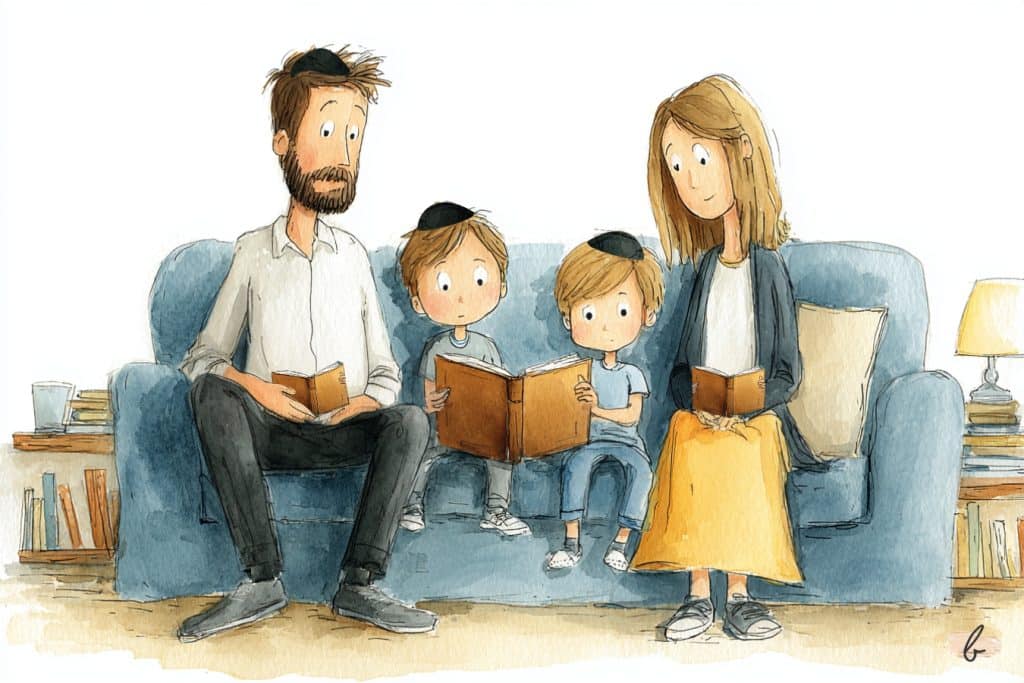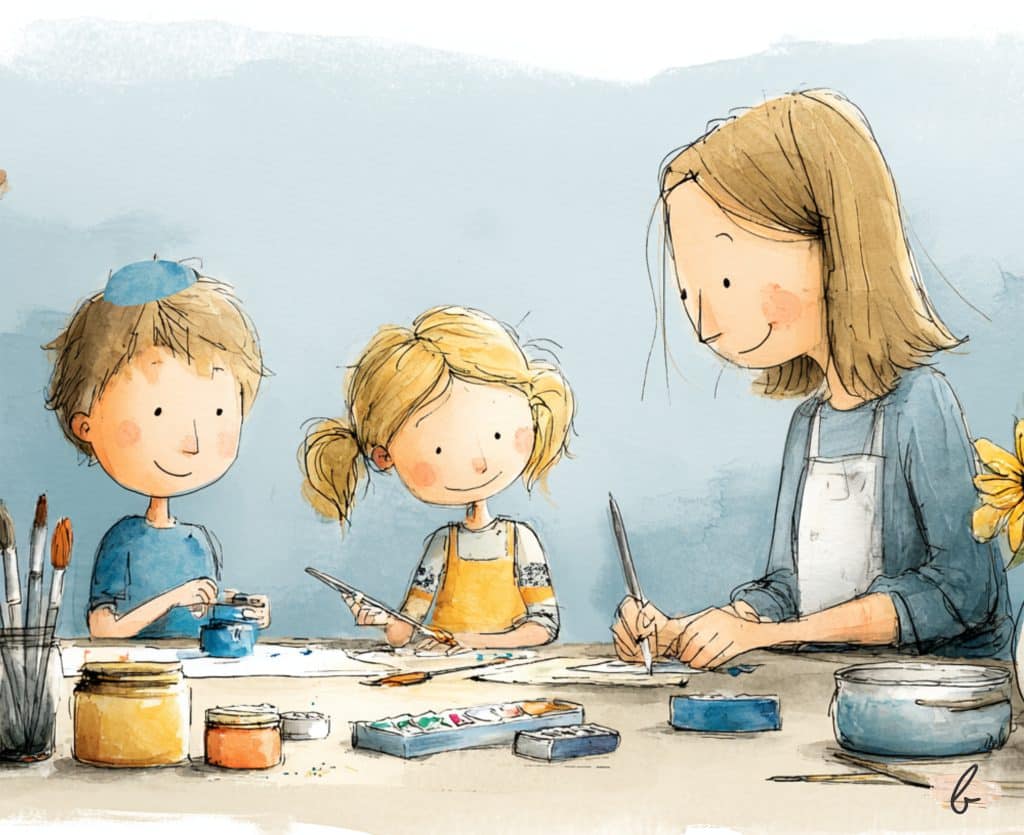Bringing the power of Elul into our homes…even when we’re still in summer mode.
It’s Elul!
When trying to think of an attention-grabbing way to start this article, I couldn’t think of a better one than the above two words. After all, like the call of the shofar, what better way to grab our attention than the reminder that this auspicious time of year, a time when Hashem is waiting to see our efforts in self-improvement and dveikus?
Our Busy End-of-Summer Distractions
It’s also a hectic time of year, as we come down from the summer highs and get thrown right into the back-to-school and prepare-for-Yom-Tov frenzies. So often, the entire month of Elul can go by without us paying much attention to its power and possibility. With young children at home, and the focus on getting them adjusted and settled in their new school year, Elul can unfortunately take a back seat, and we find ourselves racing into Rosh Hashanah, tires screeching.
But what if we involve our family in the Elul endeavor? What if we find ways to teach our children to embrace and connect with this special time of year? It’s still hard, because there are so many things we are focusing on right now, but with the right mindset, perhaps we can find simple ways to involve them.
Here are some ideas:
- Set the Tone. As always, the most effective form of chinuch is leading by example. Our children internalize what they see us do so much more than what we try to preach to them. Like I mentioned, we might be so busy that we haven’t had the time to do serious Elul introspection. But if we can find little ways to bring Elul into our day, our children will pick up on it.
*We can daven L’dovid Hashem Ori out loud, even in a special tune.
*We can say things like, “I’m not usually makpid on this, but since it’s Elul I’m going to try.” Or “It’s Elul, so I’m not going to say what’s on the tip of my tongue.”

“That driver really annoyed me but I won’t honk my horn because I’m trying to work on my middos in Elul.”
There are stories of the shtetl of old, where Elul was a palpable thing, the awe and reverence and trepidation thick enough to be felt with the hands. We aren’t quite there anymore, but if there is a way we can make Elul real for ourselves, in attitude and in action, our children will be beautifully affected.
(Of course, we need to do this carefully. Our children, especially in today’s generation, need to grow up in a happy, easygoing home. We don’t want to feed into any anxiety with, “How could you? It’s Elul?!” But joy and introspection don’t have to contradict, and we can, with our binah yeseirah, bring out the concept without introducing an atmosphere of unhealthy heaviness that will turn them off more than it turns them on. It’s more about them seeing our personal efforts vs. obligating them.)
- Finish Sefer Tehillim by Rosh Hashanah.

You can make it a family goal to finish sefer Tehillim together by Rosh Hashanah, or Yom Kippur, for that matter. This will give your children a sense of accomplishment coming into the Yom Hadin, that feeling of pride at having worked toward something meaningful together.
If you don’t already have them, Tehillim cards (or a Tehillim Mechulak) make it easy to split the entire sefer Tehillim into a perek or so per card. Keep it in a prominent place in your home throughout the month. Whenever you or your children have a few moments, have them take a card and say a perek. Keep one pile of cards that still need to be said and another pile of completed cards. Watching the second pile grow as the first pile shrinks will keep all of you motivated to keep working toward the goal.
Alternatively, at different moments throughout the month, you can work on a Yom at a time, where one person says “Aleph” and one says “Bais” and each person calls out the next perek once they are done with the previous. When there’s 3-4 people, you’ll end up completing each Yom in just fifteen minutes or so, and each person, whether child or adult, can read at their own pace during that time.
- Family Kabbalah
One of the ways we work to approach the Yom Hadin is to make a kabbalah in some area of avodas Hashem. Even when we don’t find the time or headspace for a major reckoning, a cheshbon hanefesh that comes with a comprehensive teshuvah plan, we usually try to at least come up with that one small kabbalah, that one small step that shows Hashem we are trying to better ourselves.
Why not bring this concept to the family level? Work together as a family to come up with a kabbalah that is both significant and small enough to be doable. Aim for the sweet spot where it is something that your family can struggle with, but also not one that woud be impossible to keep.
For example:
*No yelling at each other between 6 and 7 pm.
*No fighting over seats at the Shabbos table.
*Giving at least one sincere compliment to each family member every day.
*Making five brachos out loud every day.
*Being mevater for a sibling once a day.
*A family machsom, where we all don’t speak lashon hara to each other for one specific hour in the day.
*Saying asher yatzar from a card.
*Bentching together, inside a bentcher and out loud.
Make it reasonable, specific, and concrete.
There can be a prize at the end, for partial or full success in sticking to the kabbalah, or the sweet taste of accomplishment can be the prize of its own.
- Individual Kabbalos
Kabbalos are not a one-size fits all, so perhaps the above idea doesn’t sit well with you. You can still have a family-wide contest, with each person working on their own kabbalah. Depending on the age and ability of the child, they can come up with the kabbalah on their own, or you can help them think of something that will be meaningful and doable for them. You can also choose whether everyone shares their kabbalah with each other, or even just with the parents, or whether it stays a private matter, between them and Hashem.
You can turn this into a contest by having each family member keep their own chart and mark off each day that they stick to their resolutions. You can have a grading system so it’s not all or nothing. For example, each day they give themselves a number from 1-5.
5 – I kept my kabbalah perfectly
4 – I only slipped up once or twice
3 – I mostly kept it but did slip a few times
2 – I slipped a lot but I tried
1 – I hardly kept it at all
At the end of the month you count up the points and reward accordingly. You can either add up each child’s points, or you can add the entire family’s points and award a family prize. Like this, you’ve unified the family to work together toward a goal, and you’ve also given each child their own individual path toward reaching that goal together.
5. Catching Each Other
Perhaps you can’t go through all the effort of helping your family come up with specific kabbalos. They’re not the type; you’re not the type, or it’s just not happening. Here’s another idea that might be even lower maintenance and foster family unity in the process. Hang up a giant print out of an Elul calendar page. You can either blow up an actual page from a calendar or make one yourself on an oak tag. Every day, your children will catch each other doing mitzvos, going out of their way to help others, etc. They will write what they saw on that day’s square of the calendar.
“Moishy made a beautiful brachah on his snack.”
“When I wanted to read the book, Chani gave it to me right away even though she was in middle.”
Your children can watch their mitzvos building up, feel motivated to do the right thing so they can get “caught” by a sibling, and also get in the habit of looking for the positive in their sisters and brothers.
You don’t have to make a whole calendar page. You can keep a bowl or container on the counter, with slips of paper near it, and have everyone write their comments on those. At the end of the day, or at the end of the week, the family can gather around as you take turns reading the papers out loud.
Or, you can use sticky notes on a designated wall. See how many packs of sticky notes you can use up by Rosh Hashanah, or Yom Kippur, and point out to your children how many zechusim they are taking with them into the Yom Hadin!
The options are endless, and you can use your own creativity to expand on the concept, of course.
6. Family Tefillah
While we know that the point of Rosh Hashanah isn’t to serve Hashem with our list of requests for the coming year, with vending machine style tefillos, and we want to focus also on being mamlich Hashem on ourselves and on the world, there is no denying that we do feel the responsibility to do what we can to ensure a good year for us and for all of klal Yisroel. On Rosh Hashanah, our fate for the year is decided, and in the days leading up to it we want to put in all of our tefillos to both thank Hashem for everything He has given us this past year and beseech Him for continued brachah in the coming year.
We can get our family involved by having them make a list of everything they are thankful for and everything they are hopeful for. Like the kabbalos, this can be done on an individual level, or on a family level – or both!
You can give each child their own notebook to record their own gratitude and request lists, or you can create one big poster for the entire family to write theirs down together. I once shared the idea to have a Thank You Hashem poster at the family Chanukah party, and it got nice feedback. You can do the same during Elul. Hang a large oaktag that says on top, “Thank You Hashem For…”
And the children can list what they are grateful for.
“The best Mommy and Tatty in the world.”
“Our new car.”
Etc. And you can do the same for bakashos.
“Please Hashem grant us…”
“Health.”
“Shalom between our siblings.”
“Lots of nice weather this year.”
Let them make it their own by personalizing their bakashos, no matter how trivial they might seem.
7. Get Crafty – Perfect Activity for Between Camp and School!

If you are a more creatively inclined family, tap into that creativity to make the Yemei Ratzon come alive in your home. Have every family member design a poster of their own to hang around the house so that the reminders are always there.
For younger children, it can be a simple, “Rosh Hashanah is coming!” sign, with pictures of apples and honey, shofar, etc. Older children can use inspiring divrei chazal or pesukim that bring to mind this time of year.
“Ani l’dodi v’dodi li.”
“Uru yesheinim misheinaschem.”
“Melech basadeh.”
Go all out with decorating supplies and have them create beautiful posters. This can be a Sunday afternoon activity, and you can even join them at the table and design your own poster, if you are so inclined. Just creating the posters themselves will create an awareness and serve as a reminder to them that Elul is here, but it doesn’t stop there. Once the posters are hanging in prominent places around the house, they will continue to remind your family and all of your guests about these special days and their power. Special bonus points if your posters generate conversions in your home when people come to visit. You will be planting that seed of Elul into their minds and hearts, where they may have otherwise not been focusing on it!
May we all be zoche to utilize the tremendous power of these yemei ratzon together with our family, and usher in a year full of brachah for all of kllal yisroel!
Originally appeared in The Lakewood Shopper





I loved this article! A great reminder to align our focus (from end of summer and back to school) to what’s actually important today